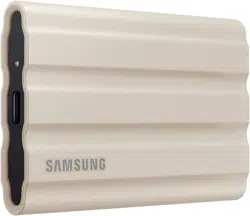Loading ...
Loading ...
Loading ...

7
System Requirements
1. USB 3.2 Gen 2 (10 Gbps) Interface Support
USB (Universal Serial Bus) is a serial input/output interface standard for connecting
various devices. T7 Shield’s data transfer speed is optimal with USB 3.2 Gen 2 (10
Gbps) and using lower versions such as USB 3.2 Gen 1 (5Gbps), USB 2.0 and 1.1 may
result in lower performances due to interface limitations inherent in such lower
versions.
* Performance may vary depending on user’s system to which the T7 Shield is connected. Since the T7
Shield’s performance may be suboptimal if your system does not support UASP (USB Attached SCSI
Protocol) even when using USB 3.2 Gen 2 connections, please make sure that your system supports
UASP.
2. Operating System Requirements
• Windows OS: Windows 7 or higher
• Mac OS: Mac OS X 10.10 or higher
• Android: Android Lollipop or higher
* The 4TB version of the T7 Shield is only compatible with a 64-bit OS.
3. File Formats
T7 Shield is pre-formatted to use exFAT files, which are supported by Windows OS,
Mac OS, and Android operating systems. As specified in the table below, whether data
formatted to a certain format may be read or written to your computer vary depending
on the OS. If you use the T7 Shield on a single OS, we recommend that you format it
using the appropriate file format for that OS.
Table 1: Read/write restrictions for file systems by each operating system.
File Formats
Windows OS
Mac OS
exFAT Both read and write Both read and write
NTFS Both read and write Read only
HFS/HFS+/APFS Not recognizable Both read and write
* When using exFAT across multiple operating systems, data writing may become locked and you may
only be able to read data. If this occurs, you can restore write access by following the instructions below.
• Mac OS: Connect the T7 Shield to your Mac again, and perform Eject.
• Windows OS: When receiving notice that write access is disabled, click “Scan and fix” to perform
Check Disk (CHKDSK). In case you closed the notice without performing Check Disk, you may
alternatively do the following: select the drive → right-click → Properties → Tools → Check.
* To perform the Time Machine function on Mac, change the file's format to APFS.
Loading ...
Loading ...
Loading ...
